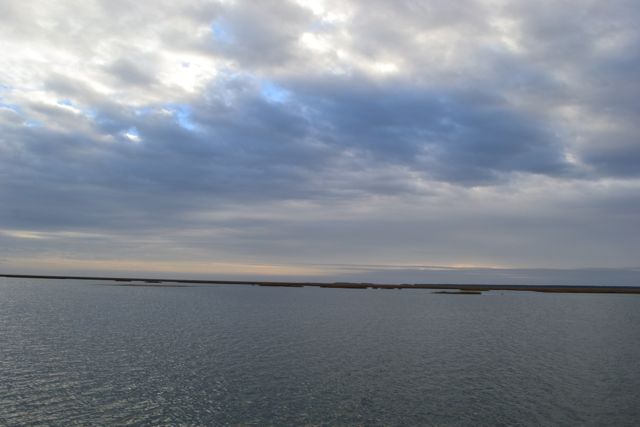 The day after Christmas broke gray, and more of the same was anticipated. A long interlude, four months, had occurred since my last sail. That warm day sail into Bulls Bay involved a discovery of a new channel out into Bull Breakers just northeast of Skimmer Key. Preparations on this December day included more careful scrutiny of clothing and Kingfisher’s rig. The halyard’s hitch on the lateen spar was half undone, and elsewhere attention was needed to prepare for the voyage to and from Bull Island. The bow handle was disturbingly corroded, recalling a day in 2003 when the predecessor sheared off in my hand as I lifted.
The day after Christmas broke gray, and more of the same was anticipated. A long interlude, four months, had occurred since my last sail. That warm day sail into Bulls Bay involved a discovery of a new channel out into Bull Breakers just northeast of Skimmer Key. Preparations on this December day included more careful scrutiny of clothing and Kingfisher’s rig. The halyard’s hitch on the lateen spar was half undone, and elsewhere attention was needed to prepare for the voyage to and from Bull Island. The bow handle was disturbingly corroded, recalling a day in 2003 when the predecessor sheared off in my hand as I lifted.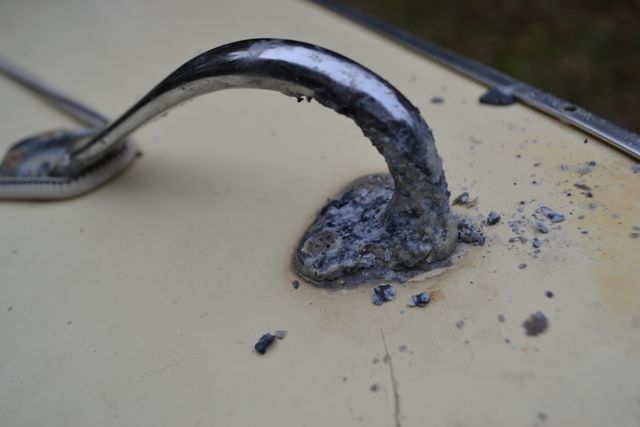 My attention to these boat issues was distracted by a white blotch on the landing’s grass, resolving into a seabird – a common tern. [Update: This is mostly likely a Forster’s Tern. I consulted about the tern species with David McLean , an expert birder who has been observing birds on the island for a number of years, and in recent years has been conducting regular surveys of the island. Check out his blog Birding Bulls – it will bring great info and joy to all you bird nerds (you know who you are).] I had never seen a tern allowing such a close approach – clearly something was wrong with this beautiful gray and white bird, set off by orange legs and some black blotching on its head marking it as a juvenile.
My attention to these boat issues was distracted by a white blotch on the landing’s grass, resolving into a seabird – a common tern. [Update: This is mostly likely a Forster’s Tern. I consulted about the tern species with David McLean , an expert birder who has been observing birds on the island for a number of years, and in recent years has been conducting regular surveys of the island. Check out his blog Birding Bulls – it will bring great info and joy to all you bird nerds (you know who you are).] I had never seen a tern allowing such a close approach – clearly something was wrong with this beautiful gray and white bird, set off by orange legs and some black blotching on its head marking it as a juvenile.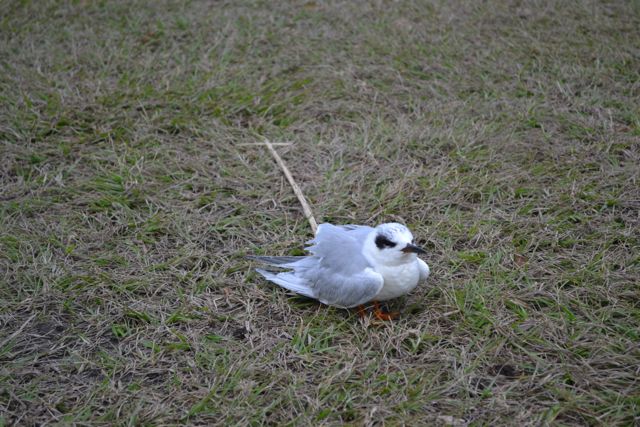
A moderate breeze from the northeast, and outgoing tide promised an easy sail of reaching and running out to the public dock on the island. Earlier at home, at the landing, and during quiet gliding in the creek, the far away drone of the island’s surf reached me. Gray skies and brown marsh reigned on the passage. Bearing off at the Shark Hole for the run down the southwestern branch of Andersonville Creek, a great blue heron crossed our course, and a dolphin made bursts along the surface. Joining the ferry route to the island, hooded mergansers swam ahead periodically, taking to the wing to maintain their distance. The dock was vacant upon our landing.
I emptied my water bag on the dock to grab my pack and hiking shoes, and discovered an epic preparation fail: I had packed two different hiking shoes, but with one common feature – they were both right-footed. I decided on an unmatched pair for the hike: left neoprene boat shoe and right hiking shoe.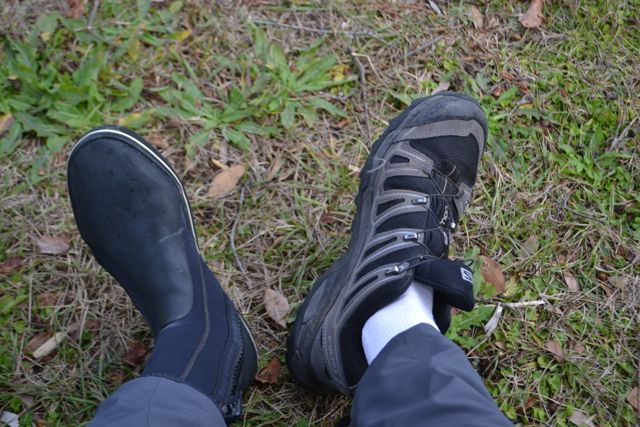 It was a bit unbalanced, but it seemed that one hiking shoe would at least save my right foot on the planned 6+ mile walk. I was reminded of the blisters and pains of long distance hikers, and committed to endure the outcome of this short walk. After a mile the dysfunction faded from my consciousness.
It was a bit unbalanced, but it seemed that one hiking shoe would at least save my right foot on the planned 6+ mile walk. I was reminded of the blisters and pains of long distance hikers, and committed to endure the outcome of this short walk. After a mile the dysfunction faded from my consciousness.
A few weeks after Hurricane Matthew a friend and I motored over to the island to take a walk, but due to damage to the public dock access to the island at this location was closed. Signs of the impact of the storm were scattered around the island, and apparent in the first minutes: chain-sawed and bulldozed trees, and a missing bench found down the road on the edge of the marsh. While walking through maritime forest near the ocean strand I peeked into the forest to view old dunes and slowly maturing live oak trees.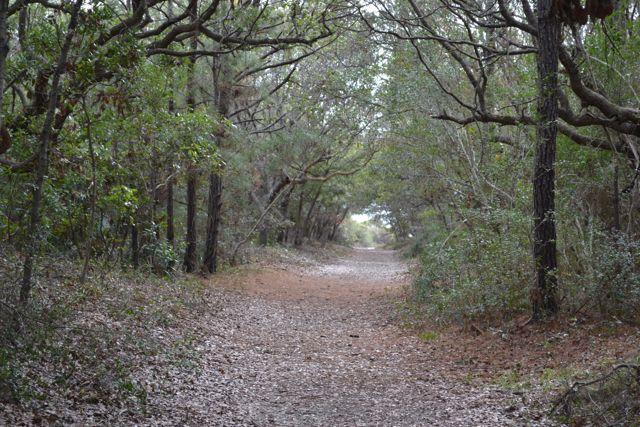 The sun was partially breaking through the overcast skies. The entrance to the beach has continued to change – high dunes rising here in recent times were long gone. A Geodetic Survey marker on the beach was just one shred of evidence of the rise of sea level.
The sun was partially breaking through the overcast skies. The entrance to the beach has continued to change – high dunes rising here in recent times were long gone. A Geodetic Survey marker on the beach was just one shred of evidence of the rise of sea level.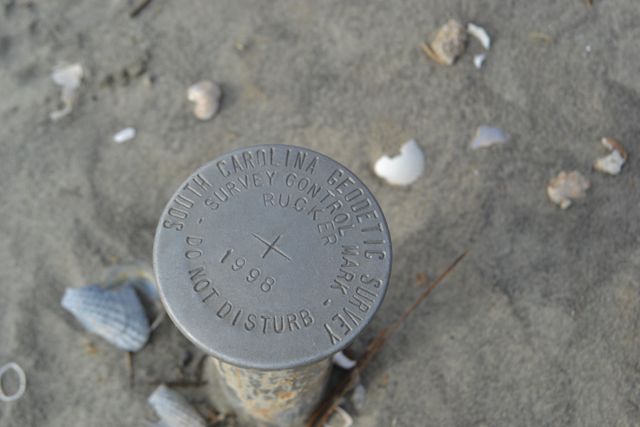
I continued to enjoy solitude on the walk toward the Boneyard on a strand absent of footprints or ATV tracks.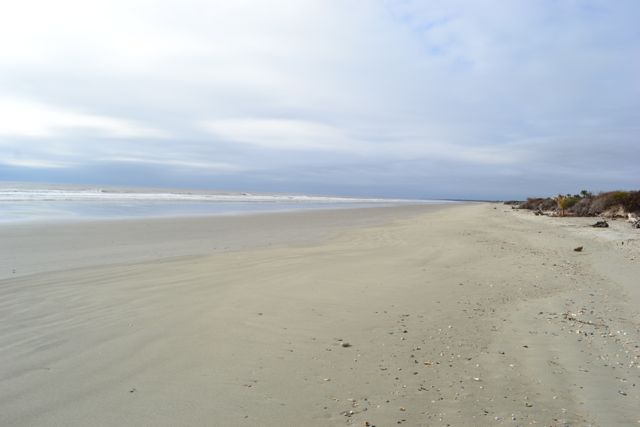 As planned I was walking a wide beach on the last hour of outgoing tide. Winter beach walks on deserted barrier islands hold the promise of marine treasures washed up on the shore, and that possibility proved to be the case along the high tide line. Besides the usual beauties – lettered olive, moon snail, young knobbed whelk, sea urchin – several chunks of coal stood out, lost cargo from a shipwreck.
As planned I was walking a wide beach on the last hour of outgoing tide. Winter beach walks on deserted barrier islands hold the promise of marine treasures washed up on the shore, and that possibility proved to be the case along the high tide line. Besides the usual beauties – lettered olive, moon snail, young knobbed whelk, sea urchin – several chunks of coal stood out, lost cargo from a shipwreck.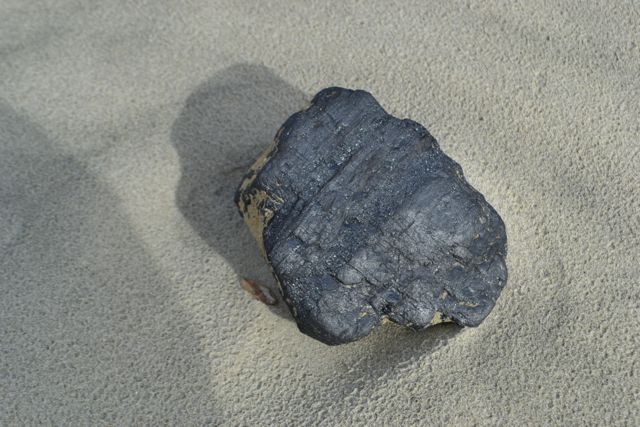 My find of the day was a murex too large to go in my pocket.
My find of the day was a murex too large to go in my pocket.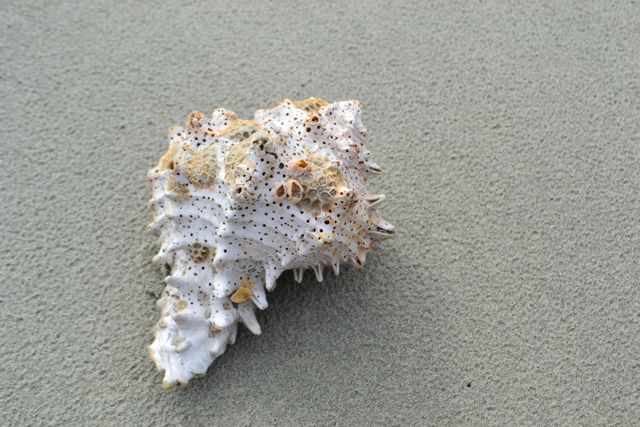 The storm’s impact on the maritime forest behind the salt shrub zone showed up as etched trees killed by the salt spray.
The storm’s impact on the maritime forest behind the salt shrub zone showed up as etched trees killed by the salt spray.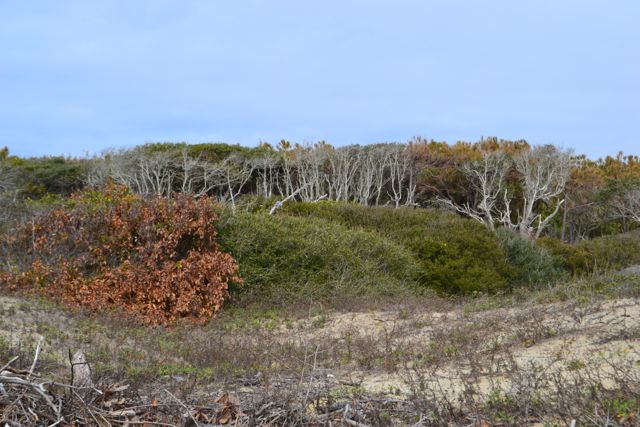 The Boneyard, a dynamic area where the maritime forest and ocean meet, appeared to be dramatically expanding to the southwest. One significant feature of the Boneyard is the area of palmetto forest at the juncture with Moccasin Pond, a natural feature of the island. The erosion at this location has opened the forest to this pond, and as in years past a beach creek had formed allowing waters to move between the pond and the ocean.
The Boneyard, a dynamic area where the maritime forest and ocean meet, appeared to be dramatically expanding to the southwest. One significant feature of the Boneyard is the area of palmetto forest at the juncture with Moccasin Pond, a natural feature of the island. The erosion at this location has opened the forest to this pond, and as in years past a beach creek had formed allowing waters to move between the pond and the ocean.
Palmetto trees littered the strand, and palmettos remaining vertical on the beach had their mop-like root system exposed. Later, I would see Moccasin Pond from the inland side, and observe its lowered water level.
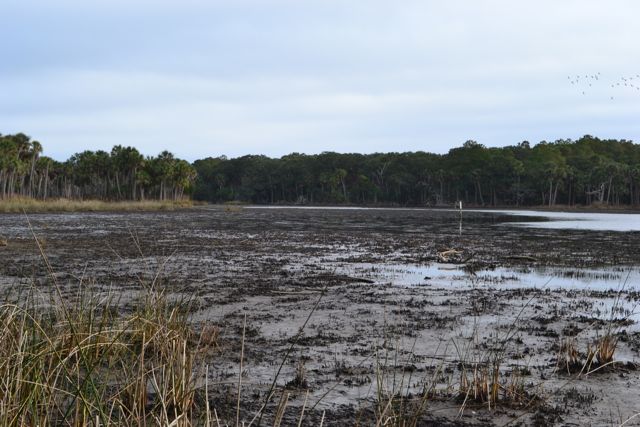
After a lunch of contemplation, I continued to walk through the Boneyard. A new area of old Refuge equipment discarded and buried was now exposed by the scouring of Hurricane Matthew; a former cache of rusted machinery had been removed in the past year.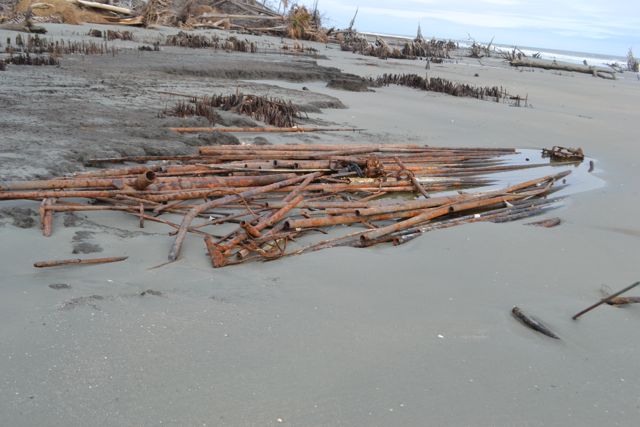
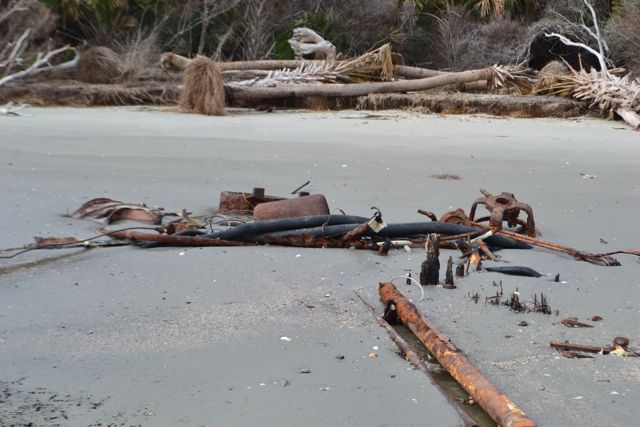 Continuing on and turning the corner to the island’s eastern face, a group of walkers came into focus down the beach. As we approached, I noted the group’s attention was directed toward a bald eagle perched on a dead oak.
Continuing on and turning the corner to the island’s eastern face, a group of walkers came into focus down the beach. As we approached, I noted the group’s attention was directed toward a bald eagle perched on a dead oak.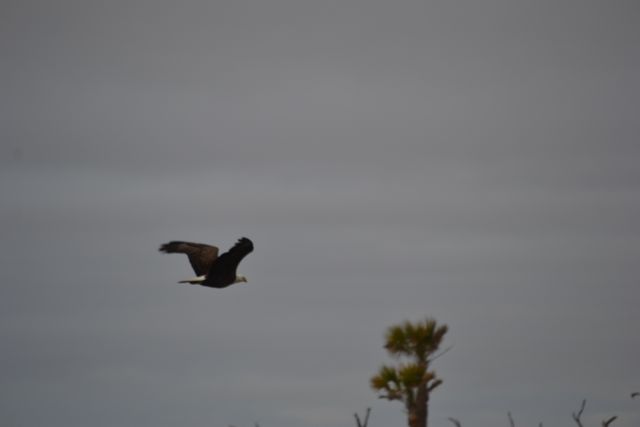 The group was led by Chris Crolley of Coastal Expeditions, who held among other objects a giant horse conch. I pulled out my own “giant”, a giant eastern murex, for display. Chris was already in interpreter mode, and pointed out several interesting features of this specimen: the attached coral, its shape indicating a southern origin; and the array of small holes throughout the shell – the result of the boring of a sponge to extract calcium.
The group was led by Chris Crolley of Coastal Expeditions, who held among other objects a giant horse conch. I pulled out my own “giant”, a giant eastern murex, for display. Chris was already in interpreter mode, and pointed out several interesting features of this specimen: the attached coral, its shape indicating a southern origin; and the array of small holes throughout the shell – the result of the boring of a sponge to extract calcium.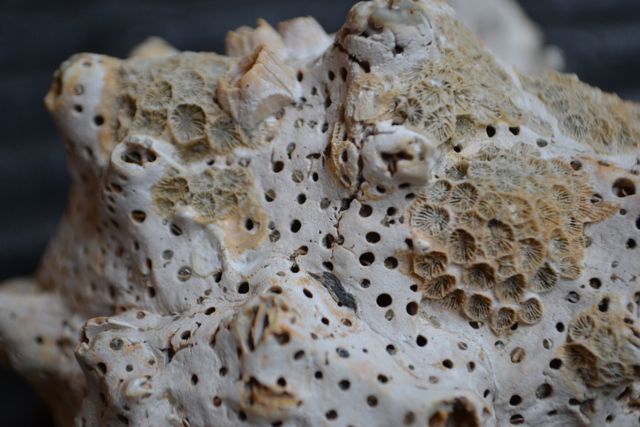 Their group had been dropped off on the Northeast Point earlier, and they continued on to the Boneyard to keep on schedule for the return trip.
Their group had been dropped off on the Northeast Point earlier, and they continued on to the Boneyard to keep on schedule for the return trip.
I backtracked to the dike separating the beach from New Pond, and had earlier noticed the significant erosion at the beach side from the storm. Wood reinforcement from the water control structure was exposed, and the large metal culvert was relocated further up the dike.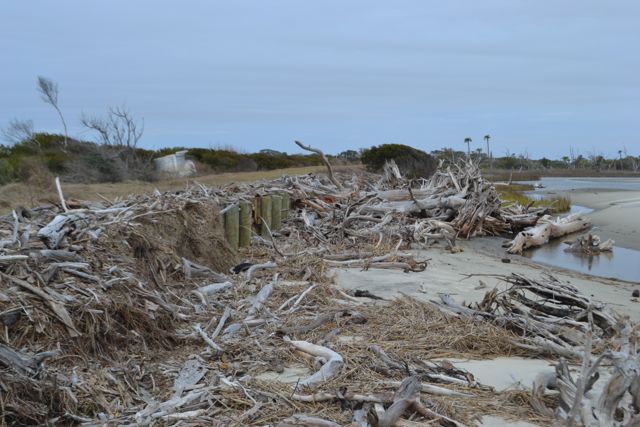
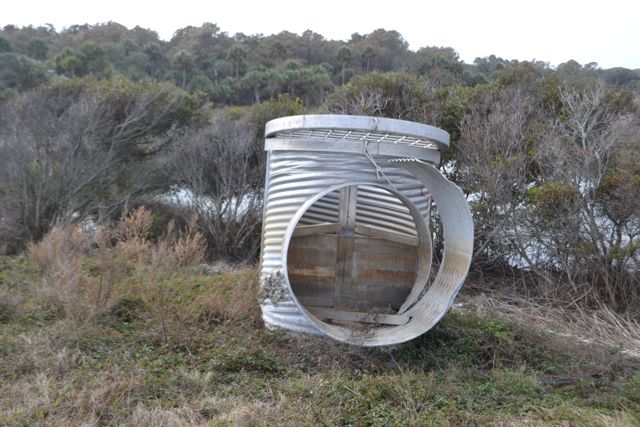 Ahead on the dike appeared two other people from Chris’s group, viewing birds with binoculars and camera.The couple were Dana and Virginia Beach who were on their way to join up with the group for lunch. I chatted briefly with them before continuing my walk back to the public dock. (No one from their group noticed my eccentric shoe combo – or perhaps they just kept it to themselves).
Ahead on the dike appeared two other people from Chris’s group, viewing birds with binoculars and camera.The couple were Dana and Virginia Beach who were on their way to join up with the group for lunch. I chatted briefly with them before continuing my walk back to the public dock. (No one from their group noticed my eccentric shoe combo – or perhaps they just kept it to themselves).
I took the road system as my return path, and found on the forested roads residual mosquitoes from the post Matthew hatch. The brief appearance of the sun was over, and the conditions were not promising for basking alligators, though Pool #2 had a few attempting to soak up the solar radiation.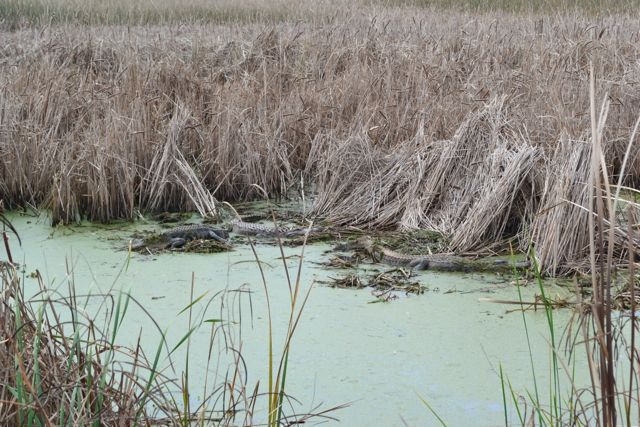 Further along, a blossom from our state flower, yellow jessamine, lay on the road, far ahead of the general blooming to come.
Further along, a blossom from our state flower, yellow jessamine, lay on the road, far ahead of the general blooming to come.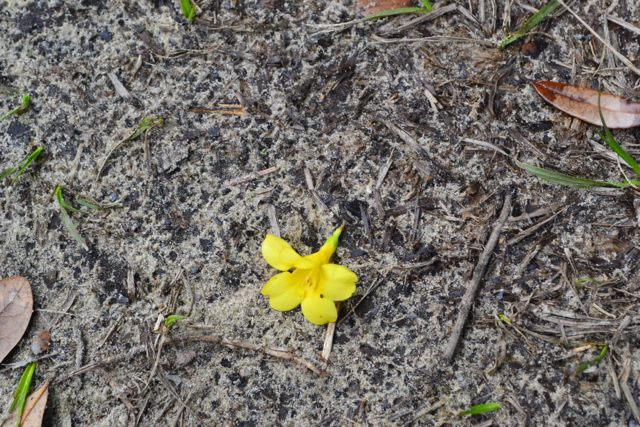 An old dune along Sheepshead Ridge Road was being “mined” for sand to fill low soggy areas along the roads.
An old dune along Sheepshead Ridge Road was being “mined” for sand to fill low soggy areas along the roads.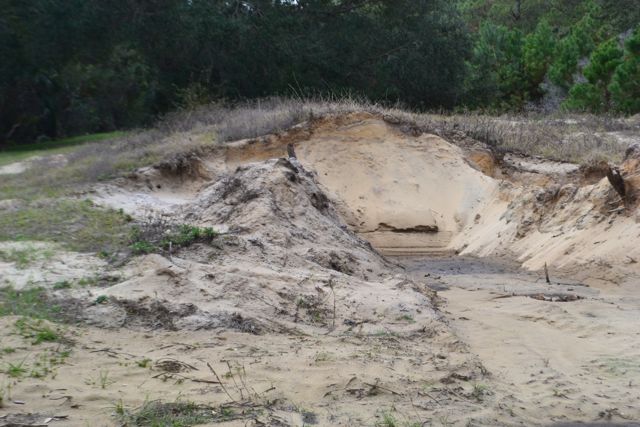 This dune and others in mid-island marked a time of higher sea level, and suggested a resilience, and the ability of this barrier island to adapt in response to future forces. There will be no beach nourishment needed on this barrier to protect unwise and unfortunate development.
This dune and others in mid-island marked a time of higher sea level, and suggested a resilience, and the ability of this barrier island to adapt in response to future forces. There will be no beach nourishment needed on this barrier to protect unwise and unfortunate development.
On the last minutes of the walk to the dock, my left foot began to complain. I expected to see Caretta at the dock, waiting to pick up the group at the Northeast Point in the afternoon, but I was surprised to see three outboards also docked. I had to work Kingfisher around two of the boats by walking through them. As predicted the wind had moderated but still maintained a consistent flow, a necessity for the windward work against the tide along this part of the homeward passage. Small groups of mergansers again led the way. I held long close hauled courses until the marsh edge obliged turning to the opposite tack. I found the release just past the Shark Hole, easing off to a reach and joining the flooding tide toward the ICW. All was simple on the final passage.
When Kingfisher was hauled out and prepared for towing home, I noticed a white spot on the grass some yards away. I went to check on the tern I left here over five hours ago, and found that the bird had expired. Even in its death, it was still a lovely animal: soft, beautifully colored, and in its short life certainly a fabulous flyer. I recalled seeing a tern actively diving and fishing during the return sail. I placed the bird in my truck’s bed for the trip home.
* * * * *
Three days later, I visited the landing to process what had been a singular day. This location on the edge of Cape Romain has always served as a place for reflection. I was brought back to the present by the jitterbug flight and staccato call of a kingfisher. Four snowy egrets flew from the impoundment toward the Refuge, and over the site of the tern’s passing. This moment, and the Monday trip, affirmed the enduring essence of the natural world.
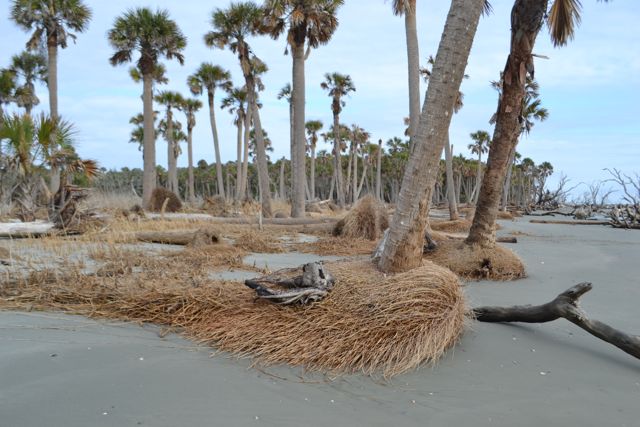
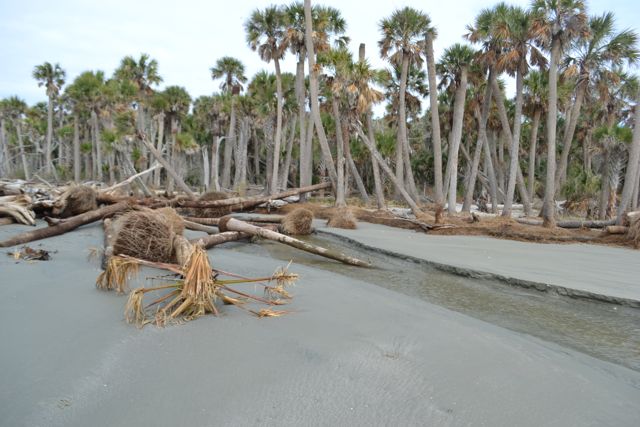
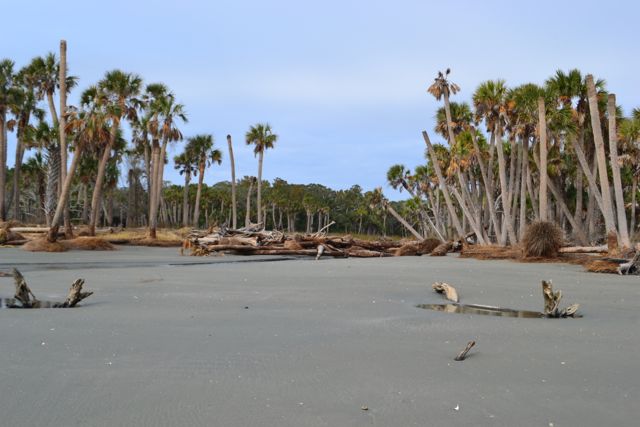
What a great way to start 2017! Thanks for sharing your sail and a “look” at Bull Is.
The long interlude just made me appreciate it all the more.
Loved this, Bob. Happy to read a new blog by you. What a beautiful, winter day in the refuge. It is a great time of year to explore our ever-changing coast.
–Gates
It is a fantastic time in the refuge.
Keep an eye out for my white sail this winter.
What a great expression of adaptation woven into a story which plays in the reader’s mind through your words. I have often pondered on this topic. Physically, chemically, emotionally, through time, relationships and natural events, it all continues to adapt. Your pictures held a thousand words! That concept helps me be more patient when things don’t quite seem right to me. Give it time to find its next place. Very well done. Thank you for sharing with us.
It is fascinating to watch the island change, along with other places in Cape Romain. What has been happening with the substantial reduction in the available nesting habitat for loggerhead turtles, and the record nests this past nesting season is remarkable.
Nice addition to the blog Bob. I’m sorry our paths didn’t cross on that wonderful winter day. They are sure to again soon though, and I look forward to that meeting and a chance to catch up.
I anticipate our paths will cross more frequently in 2017. Will see you out there, Captain.
Love it all – I want to see the bald eagles! They’re hanging around the Morris Lighthouse lately too. 🙂
The eagle last week was perched on a tree where I often see eagles.
Plenty to see in the Lowcountry.
Beautiful prose and photos! I think there may just be a purpose for mismatched hiking shoes/boots. REI might start selling them that way! Wishing you a happy, healthy 2017, Bob.
Not going to make it a habit.
You too, Kelly, for 2017